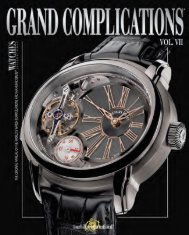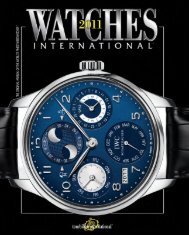180 YEARS OF
180 YEARS OF
180 YEARS OF
You also want an ePaper? Increase the reach of your titles
YUMPU automatically turns print PDFs into web optimized ePapers that Google loves.
HISTORY | <strong>180</strong> Years of Longines<br />
TECHNICAL<br />
INNOVATIONS,<br />
NEW STRUCTURES AND<br />
ongines has been involved in timing<br />
sporting events since the very beginning<br />
of the 20th L<br />
century. In 1954, the<br />
company designed and built a<br />
chronometer with a quartz movement for timing sporting<br />
events. (It happened to be as big as a suitcase.) e<br />
precision of this watch was astonishing, capable of measuring<br />
the time to 1/100 of a second. Making quartz technology<br />
small enough for personal use seemed a promising<br />
goal and Longines worked for more than 10 years on<br />
miniaturizing the quartz watch. In 1966, the company<br />
The first portable<br />
quartz clock from<br />
1954 was designed for<br />
sports timekeeping.<br />
70 | WatchTime LONGINES SPECIAL<br />
presented a huge sensation: a pocket watch with a<br />
quartz movement that immediately won rst prize from<br />
the Neuchâtel Observatory. Longines introduced another<br />
more “user-friendly” version in 1969: a wristwatch<br />
with a quartz movement. e “Ultra-Quarz” appeared<br />
at the same time as the quartz watches produced<br />
by the Japanese company Seiko. Even though quartz<br />
technology has generally been understood as a Japanese<br />
accomplishment, Longines can show that Switzerland<br />
produced groundbreaking work during the pioneering<br />
period of the quartz watch. However, it took several<br />
years until the Ultra-Quarz was ready for mass production<br />
and by that time Seiko already had its own quartz<br />
watches on the market.<br />
When Longines presented the rst quartz wristwatch<br />
with a liquid crystal display in 1972, the company<br />
counted it as another milestone in quartz technology development.<br />
Longines also continued to develop mechanical<br />
watch movements with continued success, especially<br />
with its automatic watches.<br />
But not all was well in the Swiss watch industry. Companies<br />
in the watch sector began to merge as a way to better<br />
meet the demands of the global market. Longines became<br />
a corporation in 1965, and in 1971, the company<br />
became a part of ASUAG, which also owned Ébauches<br />
SA, which later became ETA.<br />
Although Longines continued to achieve satisfactory<br />
sales numbers and entered important Asian markets, the<br />
Swiss watch industry began to experience diculties.<br />
e two largest groups in the industry, ASUAG and<br />
SSIH, were experiencing massive nancial pressures.<br />
e groups depended on Swiss banks who turned to the<br />
corporate consultant Nicolas G. Hayek (1928–2010). In<br />
1982, Hayek submitted a report in which he recommended<br />
a merger of the two groups, and in 1983, his rec-<br />
WWW.WATCHTIME.COM

















